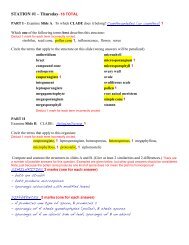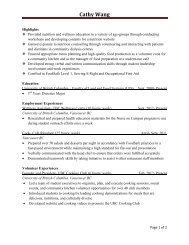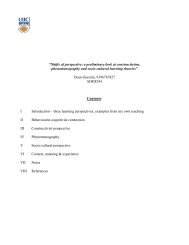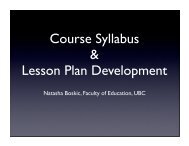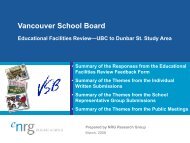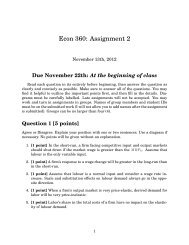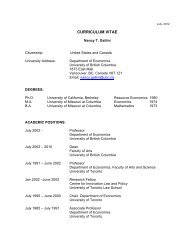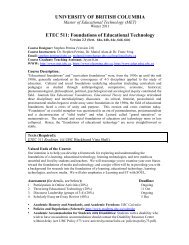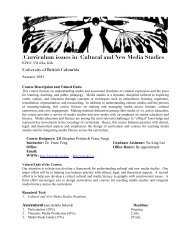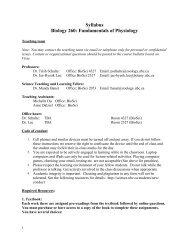Presentation - UBC Blogs - University of British Columbia
Presentation - UBC Blogs - University of British Columbia
Presentation - UBC Blogs - University of British Columbia
You also want an ePaper? Increase the reach of your titles
YUMPU automatically turns print PDFs into web optimized ePapers that Google loves.
Dr. Ramon L. Clarete, Pr<strong>of</strong>essor,<br />
<strong>University</strong> <strong>of</strong> the Philippines<br />
E-mail: ramonclarete@econ.upd.edu.ph
ASEAN Rice Trade Puzzle<br />
How does one<br />
promote rice trade<br />
in ASEAN when<br />
member states do<br />
not want to<br />
liberalize rice trade?<br />
Answer: talk about<br />
rice price volatility.<br />
Symposium on Food Security in Asia and the Pacific 17-18 September 2012 Liu Institute on Global Issues,<br />
<strong>University</strong> <strong>of</strong> <strong>British</strong> <strong>Columbia</strong>
Why rice trade is thin<br />
Internal distortion in<br />
importing countries<br />
requiring domestic<br />
rice farmers to<br />
import competition<br />
Virtual self-insurance<br />
against a food<br />
insecurity risk with a<br />
thin trade in rice<br />
Symposium on Food Security in Asia and the Pacific 17-18 September 2012 Liu Institute on Global Issues,<br />
<strong>University</strong> <strong>of</strong> <strong>British</strong> <strong>Columbia</strong>
Relative cereal price fluctuations<br />
About 95% <strong>of</strong> price<br />
fluctuations are<br />
between + or – 20%<br />
Rice has most<br />
extreme fluctuations.<br />
Table 5. Frequency distribution <strong>of</strong> monthly cereal price<br />
fluctuations,<br />
Feb 1960 - May 2012 (in percent)<br />
Categories <strong>of</strong><br />
rates <strong>of</strong><br />
monthly price<br />
changes<br />
Maize Rice Wheat<br />
>-0.3 or -0.2 or -0.1 or 0 or 0.1 or 0.2 or 0.3 or 0.4 or 0.5 or 0.6 or
Relative price volatility <strong>of</strong> cereals<br />
Rice has relatively the highest<br />
price volatility in most decades.<br />
Symposium on Food Security in Asia and the Pacific 17-18 September 2012 Liu Institute on Global Issues,<br />
<strong>University</strong> <strong>of</strong> <strong>British</strong> <strong>Columbia</strong>
Tradability and price volatility <strong>of</strong> rice<br />
In case <strong>of</strong> rice, tradability<br />
is inversely correlated<br />
with average price<br />
volatility.<br />
The inverse relationship<br />
does not hold up in the<br />
case <strong>of</strong> wheat or maize.<br />
Table 6. Average Cereal Price Volatility and Export to Output Ratios:<br />
1961 to 2010<br />
(in percent)<br />
Price<br />
Volatility<br />
Maize Rice Wheat<br />
XOR<br />
Price<br />
Volatility<br />
XOR<br />
Price<br />
Volatility<br />
XOR<br />
1961-<br />
1969 32.64 9.99 44.97 4.46 29.40 16.95<br />
1970-<br />
1979 62.72 14.88 89.45 3.94 80.86 17.07<br />
1980-<br />
1989 64.78 16.20 56.02 4.21 40.73 19.97<br />
1990-<br />
1999 56.19 13.29 70.69 5.20 61.46 18.64<br />
2000-<br />
2010 74.52 13.18 71.41 6.86 80.22 20.18<br />
1961 -<br />
2010 133.72 13.57 152.28 4.98 139.08 18.63<br />
Source <strong>of</strong> Data: FAO for trade data; WB for prices<br />
Symposium on Food Security in Asia and the Pacific 17-18 September 2012 Liu Institute on Global Issues,<br />
<strong>University</strong> <strong>of</strong> <strong>British</strong> <strong>Columbia</strong>
Effect <strong>of</strong> rice price volatility on trade<br />
Short run adjustment<br />
cost inhibits more<br />
output response.<br />
Extreme rice price<br />
volatility reduces<br />
rice trade.<br />
Self-sufficiency (U A )<br />
can be preferred to<br />
U(p e ), expected<br />
welfare.<br />
Symposium on Food Security in Asia and the Pacific 17-18 September 2012 Liu Institute on Global Issues,<br />
<strong>University</strong> <strong>of</strong> <strong>British</strong> <strong>Columbia</strong>
Granger causality test<br />
Excessive price volatility appears to cause rice<br />
trade to be low.<br />
Test #1: Price volatility Granger causes lower trade<br />
Dependent variable: quant (Rice exports)<br />
Test #2: Low trade Granger causes price volatility<br />
Dependent variable: extreme price volatility (exconst)<br />
Log likelihood = -1.163e+11 Prob > chi2 =<br />
0.0000<br />
quant Coef. Std. ERR, z Remarks<br />
Dependent variable: quant<br />
quantlag<br />
quantlag2<br />
exconstlag<br />
exconstlag<br />
2<br />
0.3695033 0.0292251 12.64<br />
0.0596144 0.0155061 3.84<br />
-<br />
*significant at<br />
0.0417605 0.0242242 -1.72 10 %<br />
-<br />
0.0539147 0.0402726 -1.34 insignificant<br />
Wald chi2(4) = 242.09 Prob > chi2 = 0.0000<br />
Prob > chi2 = 0.0649* pairwise significant at 10%<br />
Log likelihood = -7602.101 Prob > chi2 = 0.0071<br />
quant Coef. Std. ERR, z Remarks<br />
excon<br />
stlag -0.0564815 0.0220887 0.011<br />
excon<br />
stlag2 0.0596603 0.0201787 0.003<br />
quantl<br />
ag 0.000671 0.0134203 0.960 insignificant<br />
quantl<br />
ag2 -0.0163969 0.0123545 0.184 insignificant<br />
Wald chi2(4) = 14.89 Prob > chi2 = 0.0049<br />
Symposium on Food Security in Asia and the Pacific 17-18 September 2012 Liu Institute on Global Issues,<br />
<strong>University</strong> <strong>of</strong> <strong>British</strong> <strong>Columbia</strong>
Estimates from a gravity model <strong>of</strong> rice<br />
trade<br />
Volatility<br />
dampens<br />
rice trade<br />
Estimates<br />
from a<br />
gravity<br />
model <strong>of</strong><br />
trade<br />
Excessive<br />
volatility<br />
reduces<br />
trade.<br />
Symposium on Food Security in Asia and the Pacific 17-18 September 2012 Liu Institute on Global Issues,<br />
<strong>University</strong> <strong>of</strong> <strong>British</strong> <strong>Columbia</strong>
Reducing extreme rice price volatility: a<br />
framework<br />
Rice stocks<br />
Rice market information and intelligence<br />
Rice trade facilitation<br />
Symposium on Food Security in Asia and the Pacific 17-18 September 2012 Liu Institute on Global Issues,<br />
<strong>University</strong> <strong>of</strong> <strong>British</strong> <strong>Columbia</strong>
Rice stocks<br />
Rice market vulnerable to extreme price volatility with<br />
low stocks to use ratios<br />
Reserves strengthen confidence <strong>of</strong> stakeholders in rice<br />
trade.<br />
Categories <strong>of</strong> rice reserves: emergency vs. smoothing<br />
intra- or multi-year price volatility (strategic reserves)<br />
Timmer suggests: reserves at four levels, private, country<br />
reserves (small importing), country reserves (large<br />
producing, importing), and international reserves.<br />
Symposium on Food Security in Asia and the Pacific 17-18 September 2012 Liu Institute on Global Issues,<br />
<strong>University</strong> <strong>of</strong> <strong>British</strong> <strong>Columbia</strong>
Proposals on rice stocks<br />
Increase stocks to use ratios<br />
Information sharing about rice stocks.<br />
International food agency to coordinate the<br />
operations <strong>of</strong> the reserves, to gather and<br />
disseminate information about food stocks.<br />
Emergency reserves, von Braum and Torero<br />
suggests about 5 % <strong>of</strong> food aid flows.<br />
Symposium on Food Security in Asia and the Pacific 17-18 September 2012 Liu Institute on Global Issues,<br />
<strong>University</strong> <strong>of</strong> <strong>British</strong> <strong>Columbia</strong>
What ASEAN may consider<br />
Determining the appropriate size <strong>of</strong> reserves<br />
o Strategic reserves depend upon the reliability <strong>of</strong> sourcing<br />
imports from sources, availability <strong>of</strong> substitutes, and the<br />
holding cost.<br />
ASEAN Plus 6 emergency rice reserves?<br />
o Bangladesh, India, and Pakistan<br />
Symposium on Food Security in Asia and the Pacific 17-18 September 2012 Liu Institute on Global Issues,<br />
<strong>University</strong> <strong>of</strong> <strong>British</strong> <strong>Columbia</strong>
Market information and intelligence (1)<br />
Trade shocks are not fundamental explanations for the<br />
price bubble in 2008.<br />
Speculative herding behavior<br />
Importance <strong>of</strong> generating and disseminating accurate<br />
market information<br />
More important side is the interpretation <strong>of</strong> the<br />
information.<br />
Need for tools to analyze the impact <strong>of</strong> supply and<br />
demand shocks as well as policy changes.<br />
Symposium on Food Security in Asia and the Pacific 17-18 September 2012 Liu Institute on Global Issues,<br />
<strong>University</strong> <strong>of</strong> <strong>British</strong> <strong>Columbia</strong>
Market information and intelligence (2)<br />
AFSIS as gathering basic statistics about the regional<br />
rice market.<br />
Need for sharing market intelligence (e.g. close to<br />
real time stocks to use ratios, trade flows, policy<br />
developments, supply and demand shocks, etc.)<br />
Symposium on Food Security in Asia and the Pacific 17-18 September 2012 Liu Institute on Global Issues,<br />
<strong>University</strong> <strong>of</strong> <strong>British</strong> <strong>Columbia</strong>
Policy options for trade<br />
Coordinated investments to expand export capacity <strong>of</strong><br />
ASEAN in Myanmar and Cambodia<br />
Reduced self-sufficiency targets for guaranteed rice<br />
imports<br />
Clear set <strong>of</strong> criteria on the ATIGA waiver (Article 24)<br />
A de-coupled Thailand’s paddy pledging program<br />
Expanded coordinated rice policy action (w/ China,<br />
India, Pakistan?)<br />
Symposium on Food Security in Asia and the Pacific 17-18 September 2012 Liu Institute on Global Issues,<br />
<strong>University</strong> <strong>of</strong> <strong>British</strong> <strong>Columbia</strong>
Rice trade forum<br />
ASEAN rice trade forum,<br />
platform for (1) sharing<br />
market information and<br />
intelligence, (2) coordinating<br />
policy responses to crisis<br />
situations, and (3)<br />
negotiations among importers<br />
and exporters.<br />
Continue the implementation<br />
<strong>of</strong> the Rice Trade Forum in<br />
ASEAN.<br />
Symposium on Food Security in Asia and the Pacific 17-18 September 2012 Liu Institute on Global Issues,<br />
<strong>University</strong> <strong>of</strong> <strong>British</strong> <strong>Columbia</strong>
Thank you.<br />
Symposium on Food Security in Asia and the Pacific 17-18 September 2012 Liu Institute on Global Issues,<br />
<strong>University</strong> <strong>of</strong> <strong>British</strong> <strong>Columbia</strong>
For information, contact:<br />
ladriano@adb.org<br />
ramonclarete@econ.upd.edu.ph




